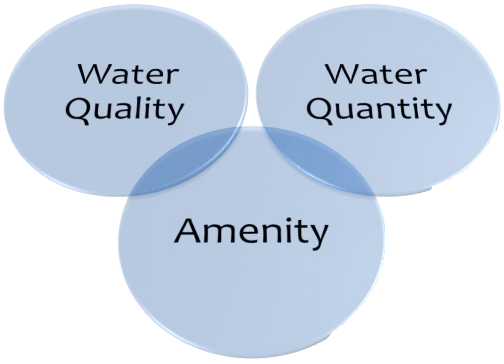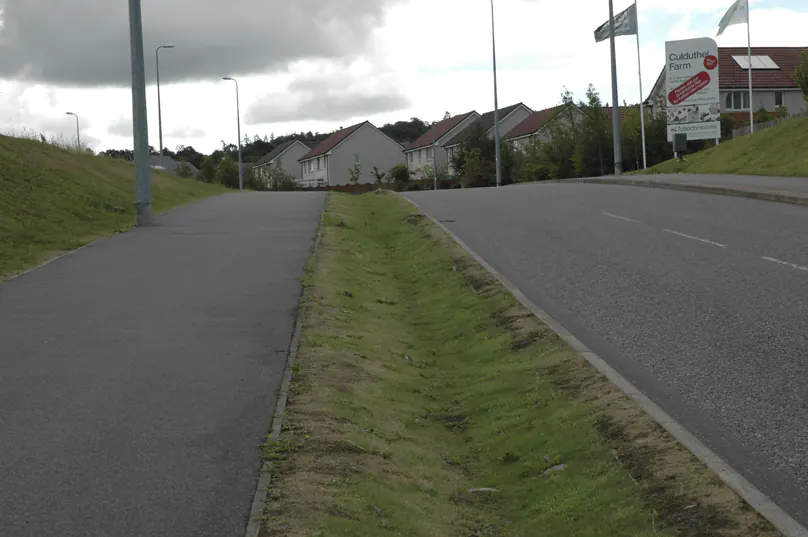A Brief Overview of SuDS
The term SuDS is an acronym for Sustainable Urban Drainage Systems. SuDS, were first established in the United States and originally known as Best Management Practice (BMP). When adopted in Scotland, the name underwent a change to better reflect the process. The latest Scottish building standards include the system for both urban and rural developments. To reflect this, the word “Urban”, is no longer used. For the same reason, the “u” in SuDS is now lower case.
Diffuse Pollution
SuDS were developed to solve the problem of diffuse pollution. Pollution that has no specific point of discharge as distinctive from point source pollution, such as end of pipe discharges. In a natural environment after heavy rainfall most of the surface water either is taken up by plants, infiltrates into the ground, or evaporates leaving only a small percentage to run-off across the surface and enter watercourses such as burns, rivers or lochs. Impermeable areas cover more of the natural ground surface within urban areas. These impermeable surfaces are buildings, roads and footpaths. This reduces the amount of rainfall that can infiltrate into the ground, increasing the surface water run-off significantly. When rainwater runs off impermeable surfaces the water picks up pollutants that are on these surfaces and transports them into the watercourses causing diffuse pollution of rivers, lochs and groundwater.
Pollutants
Pollutants consist of many things. These range from tiny pieces of solid or liquid matter emitted during vehicle engine combustion. The moving parts of vehicles produce tiny pieces of zinc, copper, lead, nickel, and cadmium due to wear. Other sources of pollutants released into the air include soot particles from chimneys, fungal spores and dust. These air pollutants disperse onto impermeable surfaces such as roofs and roads during rainfall. Other pollutants such as pet faeces, oils, petrol, and soap or detergents from car washing can settle onto roads and driveways. As the surface water runs off into the sewers, it transports all these pollutants into the nearest water course, producing one form of diffuse pollution.
Surface Water Sewers
Conventional sewers simply collect and transport the surface water and have no way of removing most of these microscopic pollutants. The only treatment that conventional pipework sewers can provide is silt traps to collect larger pollutants. Diffuse pollution was a problem during the 1990s in Scotland. To resolve this issue and improve water quality, surface water run-off would require a method of treatment to reduce pollutants. SuDS attempts to provide this treatment.
Unlike conventional drainage systems, SuDS adopt the earth’s natural processes to provide treatment of rainfall run-off. These include infiltration, evaporation, evapotranspiration, settlement, biological digestion and adsorption. The concept of SuDS is a radical new way of thinking about drainage systems and is based on a holistic approach with three objectives that make up the SuDS triangle.
The SuDS Triangle
The SuDS triangle consists of three legs. Water Quality to prevent pollution, Water Quantity to provide flood prevention and the third objective of Amenity to provide landscaping and improve biodiversity.
In order to rationalize SuDS at various scales, the concept of a treatment train has been developed. The treatment train starts with reducing sources of pollution. Next, this is followed by providing SuDS source control devices as close to the pollution as possible. Then, followed by site control SuDS devices and finally regional control devices.
Types of SuDS Devices
There are many SuDS devices available. Source control devices include soakaways, swales, filter strips, water butts, green roofs and rain gardens. Filter drains and swales are often used along roadsides to collect the run-off from roads. Filter drains and swales are frequently a transport method for surface water. Site and regional control devices can range from retention ponds, detention basins or if space allows wetlands.
These are soft solutions as they use natural materials such as vegetation, structural landform or gravels to provide attenuation and treatment. They may also provide the third objective of SuDS if well-designed by adding to the amenity value of an area.
Sometimes SuDS devices are man-made components, classed as hard solutions. Permeable surfaces, frequently used as source control, allow water to infiltrate back into the ground. Site control devices can be provided by underground storage tanks and Stormcells. These types of devices provide attenuation, often used for flood management. However, they provide only limited treatment due to very little settlement or biological digestion. They do however, improve the amenity value as they are below the ground.
Sustainable Drainage System Video
A brief overview of Sustainable Urban Drainage Systems (SuDS) is provided by this video. It helps explain the development and process of designing SuDS.





